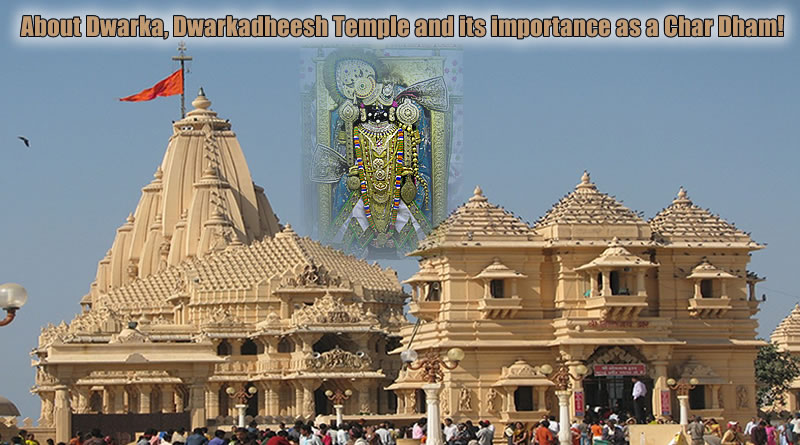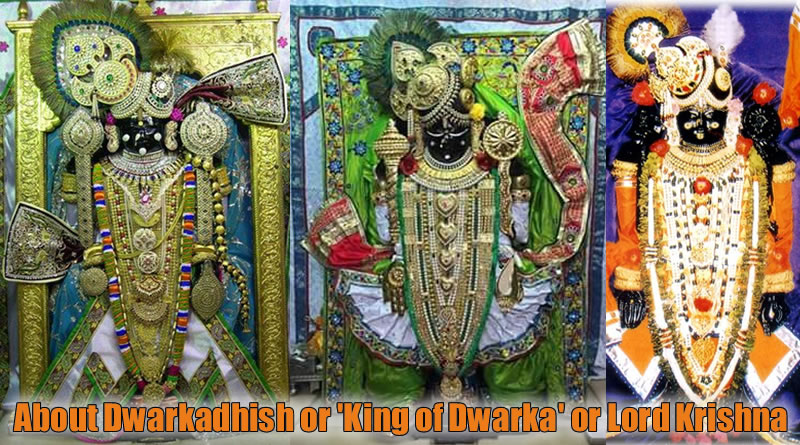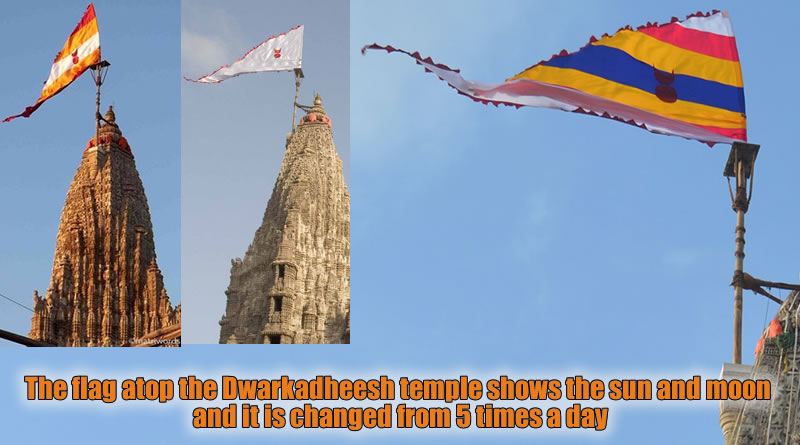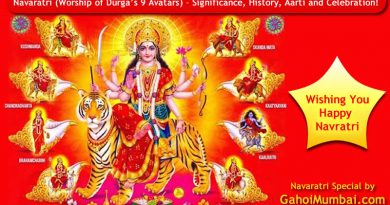About Dwarka, Dwarkadheesh Temple and its importance as a Char Dham!
Dwarka is one of the significant Dham in all four Char Dham. Dwarka is derived from ‘Dwar’, a door, and in ancient times its flourishing port was considered to be the gateway to the main land. As ‘Ka’ means ‘Brahma’ meaning, gateway to Moksha. It is called Dwarkamati and Dwarkavati. Being adopted home and capital of Shri Krishna after he gave up Mathura. It is held in such a high esteem as a place of Hindu pilgrimage that it is considered to be one of the four principle holy places or Char Dham, it is also famous as Mokshapuri.
About Dwarka Town:
Dwarka is also spelled Dwarika, and Dwaraka is a city and a municipality of Devbhoomi Dwarka district in the Gujarat state of India. Dwarka is one of the leading Chardham in four holy Hindu pilgrimage sites, and is one of the Sapta Puri seven most ancient religious cities in the country. Dwarka is often acknowledged with the Dwarka Kingdom, the ancient kingdom of Krishna and is believed to have been the first capital of Gujarat.
The Dwarkadheesh Temple was built around 200 BCE and was enlarged in the 17th century. Prior to the reallocation of the districts, this city was part of Jamnagar District.
Geographical site of Dwarka:
Dwarka is a city and municipality located in Jamnagar district in Indian state of Gujarat. It is known to be located in the western most part of Gujarat. This city was historically known as the Golden city. Dwarka is a significant city according to Hindu religion, as it serves as one of the Chardham as well as Sapta-puri (seven sacred cities) sites. As the name suggests, it is believed to be a gateway to spiritual union with Lord Brahma. This city finds association with sacred texts of Hindu religion such as Gita and Puranas.
About Dwarkadheesh temple and its history and architecture:
The Dwarkadhish temple, also well-known as the Jagat Mandir and sometimes spelled “Dwarakadheesh” is a Hindu temple enthusiastic to Lord Krishna, who is worshipped here by the name Dwarkadhish, or ‘King of Dwarka’. The main shrine of the 5-storied building, supported by 72 pillars, is known as Jagat Mandir or Nija Mandir, archaeological findings suggest it to be 2,200 – 2,000 years old. Temple was enlarged in the 15th- 16th century. The Dwarkadhish Temple is a Pushtimarg temple; hence it follows the guidelines and rituals created by Shree Vallabhacharya and Shree Vitheleshnathji.
Dwarakadeesh temple has a long history of 2500 years. The main god of the temple is Lord Krishna. It is a beautiful temple with excellent creative expressions. The main building of the temple is five stories high and is supported by 60 roof columns making it the major attraction of this impressive structure. Lord Krishna in his black idol looks so striking and attractive that the followers coming to this temple to offer prayer feel the existence of the lord in the temple. The other shrines present within the temple complex are dedicated to Sathybhama Devi, Subhadra, Balarama and Revathy, Jambavathi Devi, Vasudeva, Rukmini Devi and Devaki. Affluent carvings and creative structural designs of the holy place attract every visitor with its graceful appeal.
The flag atop the temple shows the sun and moon and it is changed from 5 times a day, but the symbol remains the same.
The temple is a five-story structure built on seventy-two pillars. The temple spire is 78.3m high. It is constructed of limestone which is still in pristine condition. It shows intricate sculptural detailing done by successions of dynasties that ruled the region. The structure was not expanded much by these works.
Lord Krishna’s grandson, Vajranabha, is said to have built the original temple of Dwarkadhish over the hari-griha (Lord Krishna’s residential place).
There are two entrances to the temple. The main entrance (north entrance) is called “Moksha Dwara” (Door to Salvation). This entrance takes one to the main market. The south entrance is called “Swarga Dwara” (Gate to Heaven).
Outside this doorway are 56 steps that leads to the Gomati River.
Dwarka history and its associated Myths:
The town of Dwarka in Gujarat has a history that dates back centuries, and stated in the Mahabharat epic as the Dwaraka Kingdom. Situated on the banks of river Gomti, the town is known of being the capital of Lord Krishna.
Archaeological excavations have uncovered underwater stone structures which have been described as showing settlement during proto-historic times. Evidence such as a stone block with Gujarati script, the way the stones were dressed showing that dowels had been used, and an examination of anchors found on the site suggest that the harbour site dates only to historical times, with some of the underwater structure being late Medieval. Coastal erosion was possibly the cause of the destruction of what was an ancient port.
About Dwarka – A Char Dham Pilgrimage:
Dwarka Dhaam got its significance in the time period of Dwapar Yug when Lord Krishna – an avatar of Lord Vishnu, made Dwarka his residence in place of his birthplace Mathura.
Dwarka (The Suvarna Nagari) the headquarters of Okhamandal taluka is in the extreme west of the Saurashtra peninsula on the Arabian Sea. Dwarka lies on 20.22′ north latitude and 69.05′ east longitude and built on the night bank of Gamut creek. Dwarka was known as the city of Gold. Shree Krishna came here from Mathura along with some Yadav families and establishes his own empire Dwarka. That was the legend but science proved it partially. Scientists researched on that and have found some facts.
Dwarka is derived from ‘Dwar’, a door, and in ancient times its flourishing port was considered to be the gateway to the main land. As ‘Ka’ means ‘Brahma’ meaning, gateway to Moksha. It is called Dwarkamati and Dwarkavati. Being adopted home and capital of Shri Krishna after he gave up Mathura. It is held in such a high esteem as a place of Hindu pilgrimage that it is considered to be one of the four principle holy places or Char Dham, it is also famous as Mokshapuri.
As per to tradition, the original temple was believed to have been built by Krishna’s grandson, Vajranabha, over the hari-griha (Lord Krishna’s residential place). The temple became part of the Char Dham pilgrimage considered sacred by Hindus in India, after Adi Shankaracharya, the 8th century Hindu theologian and philosopher, visited the shrine. The other three are Rameswaram, Badrinath and Puri. Even today a memorial within the temple is devoted to his visit.
Dwarakadheesh is the 108th Divya Desam of Lord Vishnu on the subcontinent, glorified in the Divya Prabandha sacred texts.
There are five jewels in Saurashtra, namely rivers, women, horses the fourth Somnath and fifth is the darshan of the idol of Hari or Shri Krishna’.
Dwarkadheesh temple along with Nageshwar Mahadev, Rukmini Temple, Bhalka Tirth, and Gomati Ghat Temples are few of the well-known Dwarka attractions.
Various other attractions in Dwarka are Dwarkadeesh Temple, Nageshwar Jyotirlinga Temple, Gomti Ghat, Beyt Dwarka, Gita Mandir, Rukshamanee Mandir, Scuba Diving, Siddheshwar Mahadev Mandir, Bhadkeshwar Mahadev Mandir etc.
Suitable Time to Visit Dwarka:
The temple is open in every season from 6.00 am to 1.00 pm and 5.00 pm to 9.30 pm (On all the working days except Public Holidays).
How to reach Dwarka – A Char Dham:
Dwarka is reachable by air, railways and roadways. It is well connected by rail with cities like Chennai, Coimbatore, Thanjavur and Trichy. The nearest airport is in Madurai, 163 km from here. If you are traveling from some distant location then taking a flight will be the best choice.
A trip here will bring a serene feeling in your mind tired with the complexities of modern life. State transport buses regularly travel between Rameshwaram and other cities of Tamil Nadu. Hotels and guest houses provide the best facilities you can possibly have here.
By Air: There are no regular flights from other major cities of the country to Dwarka. Nearest airport is Porbandar Airport. Nearest other airports from Dwarka are Jamnagar (121 Kms. and Rajkot (225 Kms.).
1. Porbandar Airport (PBD), Porbandar, Gujarat (95 km away from Dwarka)
2. Govardhanpur Airport (JGA), Jamnagar, Gujarat (110 km away from Dwarka)
By Railway: Dwarka is well connected to other major cities of the country via regular trains. It is a station on the Ahmedabad-Okha broad gauge railway line, about 137 km from Jamnagar, 217 km from Rajkot and 378 km from Ahmedabad.
Railway Stations Code: Dwarka (DWK)
Distance of major stations from Dwarka as below given:
Jagannathpuri (2752 Kms.), Hawra (2560 Kms.), Raipur (1730 Kms.), Varansi (2071 Kms.), Jammu-Tavi (2154 Kms.), Vadodara (571 Kms.), Mumbai Central (962 Kms.), Delhi (1568 Kms.), Ahmedabad (471 Kms.), Madras (2371 Kms.), Rameshwar (2910 Kms.), Jaipur (1523 Kms.), Haridwar (1690 Kms.), Trivendram (2954 Kms.), Vishakhapatnam (2284 Kms.), Bhopal (1111 Kms.), Simla (1990 Kms.), Dhanbad (2345 Kms.)
By Road: Dwarka is well connected by road. Many state highways connect Dwarka with other nearby cities. State Transport Corporation buses connect Dwarka with nearby places through convenient transport services. You can easily get regular buses to Dwarka from other major cities of the country. A state highway with Jamnagar and Okha also connects it.
Private and State run buses do ply regularly to Dwarka from several cities of Gujarat like Ahmedabad, Porbandar, Rajkot, Vadodara, Amerli and many more.
Dwarka and Dwarkadheesh Temple at Google Map:
If you need any help regarding Hindu Pilgrimage or Hindu Pilgrimage related information, please leave your message at our Pilgrimage Help Centre or comment box.
All this information is free and only for informational purpose.







